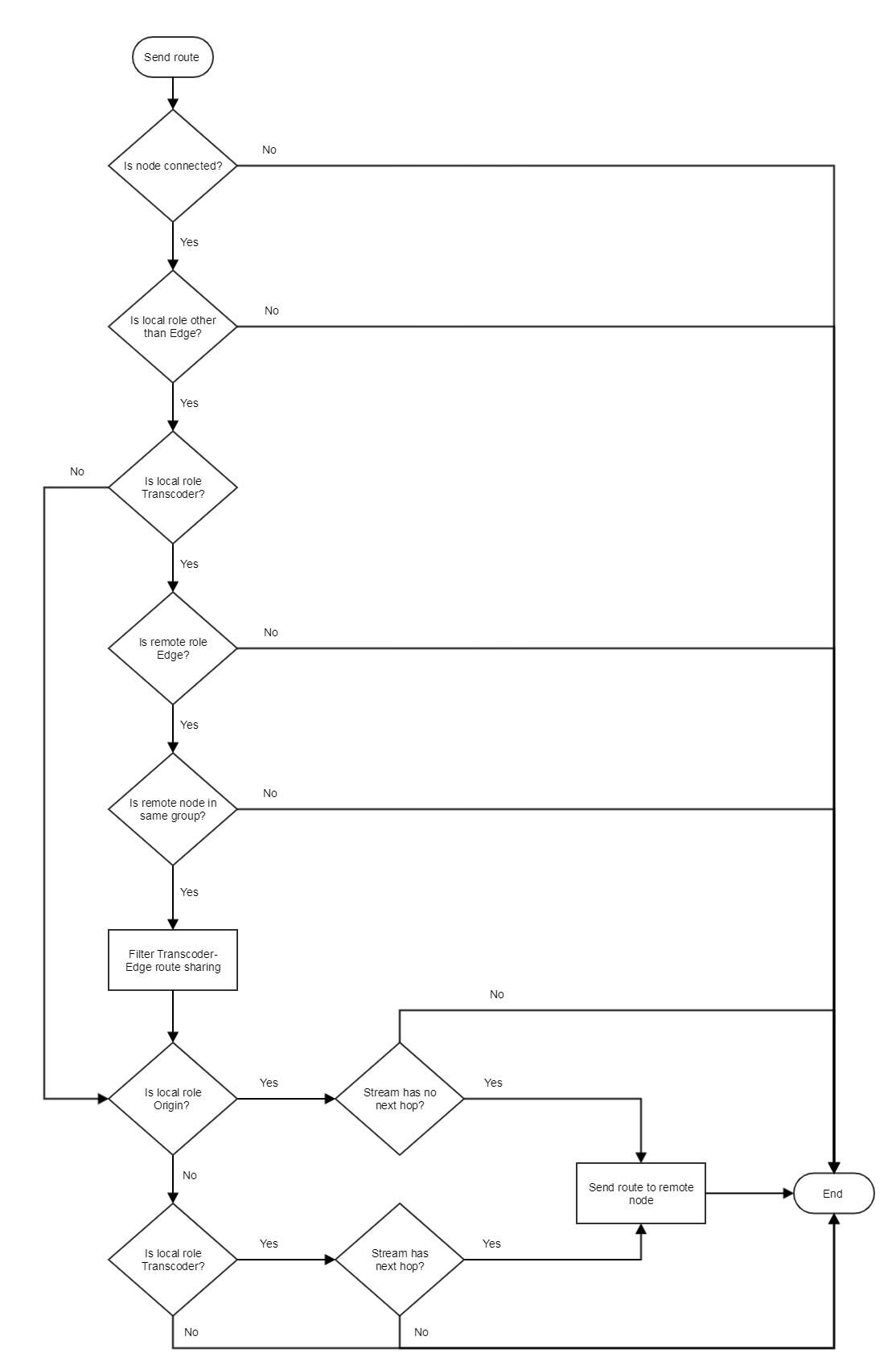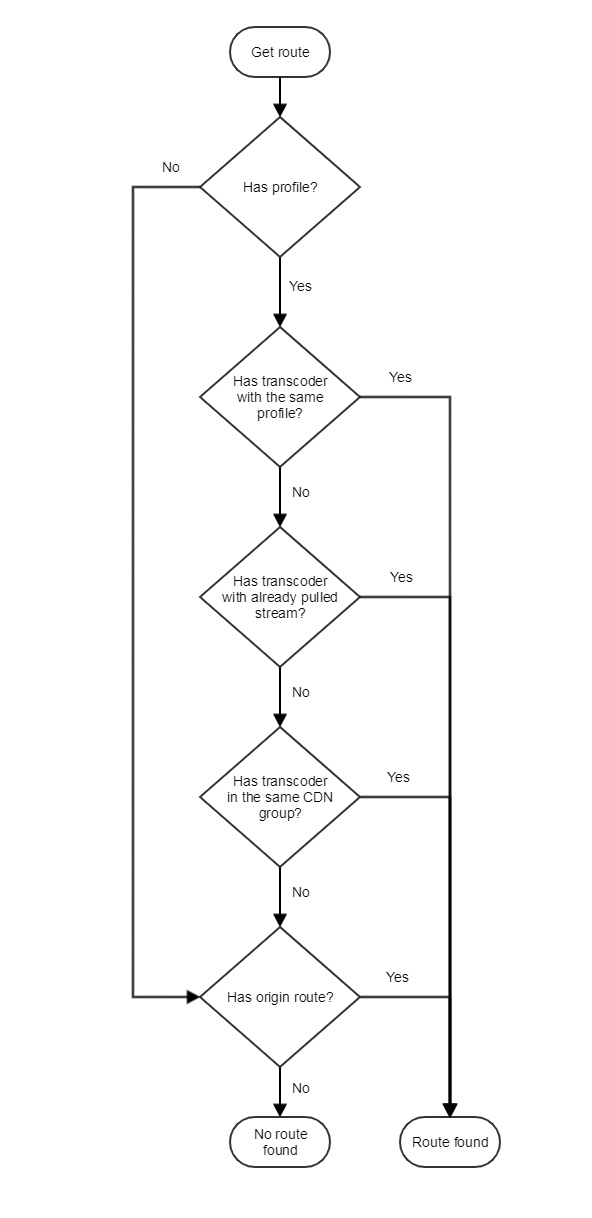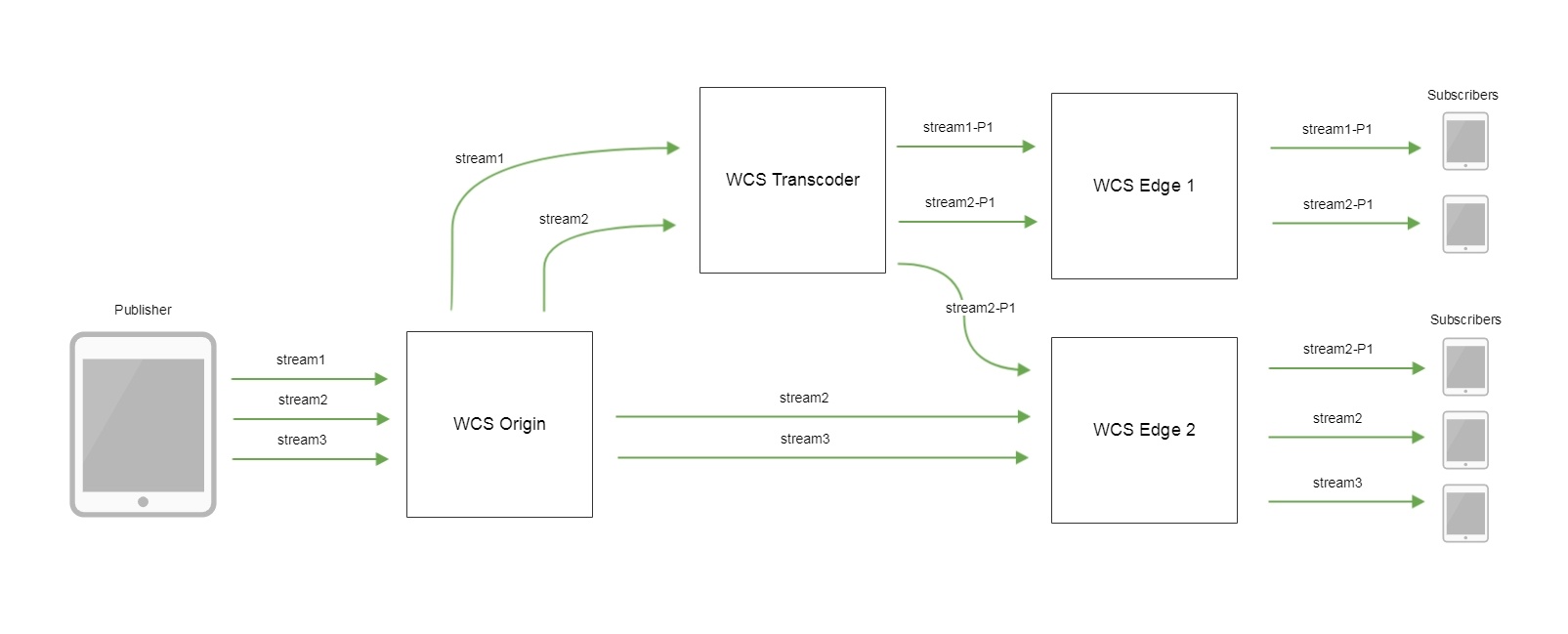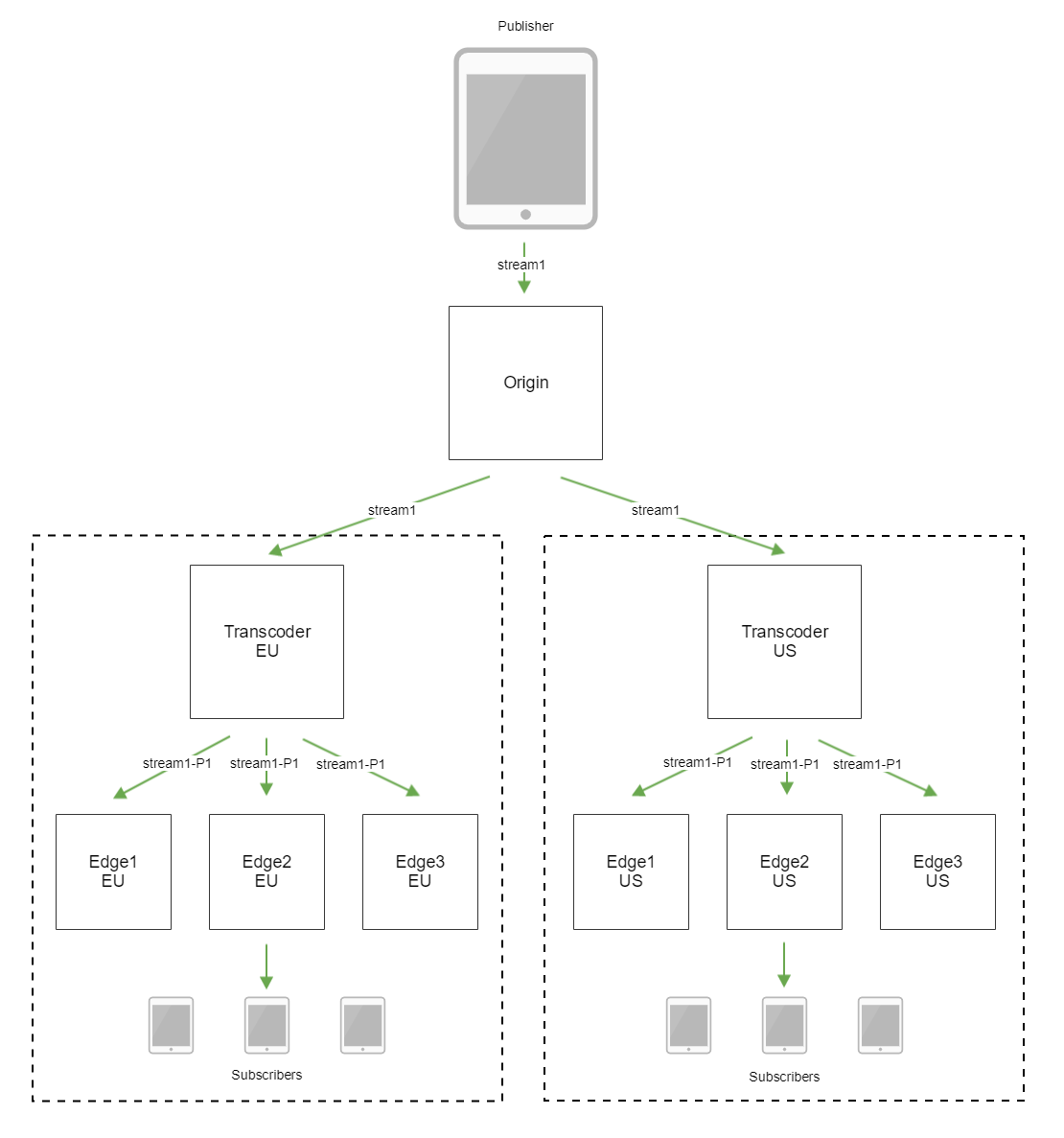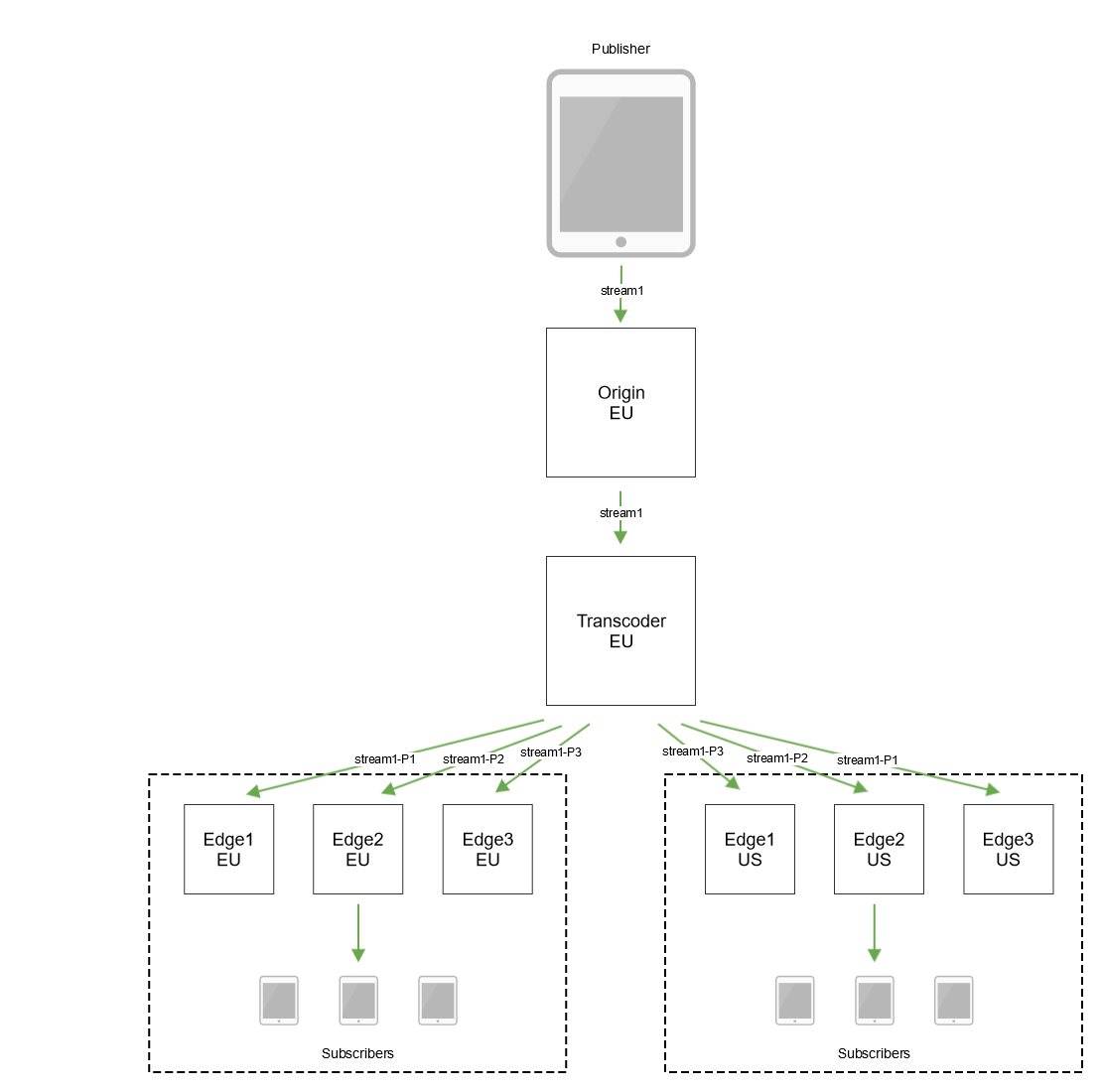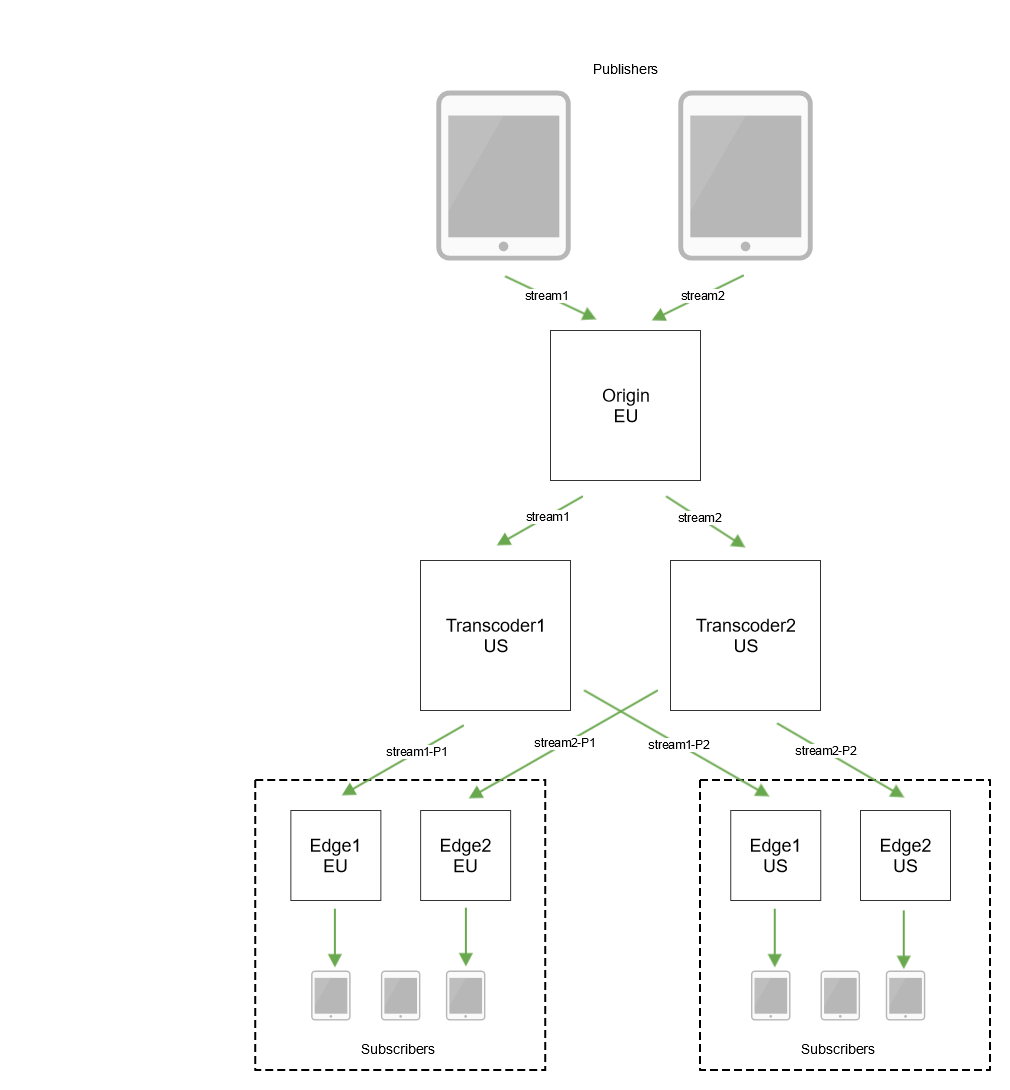Overview
New CDN 2.1 implementation includes additional features comparing with CDN 2.0:
- CDN nodes grouping by geographical (EU, US etc) or another basis
- CDN nodes can be used for transcoding purposes only by setting Transcoder role to certain nod
CDN nodes grouping
Servers in a CDN can be grouped together by geographical (location), technical (GPU using for transcoding) and another basis. CDN group can be assigned to the server with the following parameter in flashphoner.properties file
cdn_groups=group1
The same server can belong to several groups. For example, server located in Europe and used for transcoding on GPU:
cdn_groups=EU,GPU
CDN groups are used to choose a route for stream playback.
All the servers not assigned to any group are considered to belong to the same group.
Transcoder CDN nodes
In order not to load the servers used for publishing and watching videos in a CDN with transcoding tasks, it is advisable to allocate server with increased computing perfomance for these tasks. For such nodes, in addition to Origin and Edge roles, Transcoder role is added.
cdn_role=transcoder
Transcoder node cannot be used to publish or play streams. This node interacts with Origin and Edge as follows:
1. Stream is published to Origin server
2. Transcoder pulls the stream from Origin server by Edge server request.
3. Transcoder performs stream transcoding by transcoding profile set by Edge server.
4. Edge server pulls the transcoded stream from Transcoder server to play it to subscriber.
The specific node for transcoding is selected when choosing a route for stream playback
Transcoding profiles
To set up transcoding parameters, special profiles are used on Edge server. Transcoding profiles file cdn_profiles.yml should be placed in /usr/local/FlashphonerWebCallServer/conf folder on Edge server:
profiles:
-webrtc-144:
audio:
codec : opus
rate : 48000
video:
width : 256
height : 144
codecImpl : OPENH264
When stream playback is requested, transcoding profile name should be added to stream name to transcode this stream, for example
test-webrtc-144
It is recommended to set hyphenated profile names for convenience.
Server restart is necessary to apply changes in cdn_profiles.yml file.
Profile parameters
| Parameter | Values available | Description |
|---|---|---|
| Audio parameters | ||
| codec | opus mpeg4-generic speex ulaw | Audio codec to use |
| bitrate | Depends on quality required and bandwidth available | Audio bitrate, bps |
| rate | 8000 11025 12000 16000 22050 24000 32000 44100 48000 | Audio sample rate, kHz |
| channels | 1 2 | Audio channels number |
| Video parameters | ||
| codec | h264 mpv vp8 | Video codec to use |
| bitrate | Depends on quality required and bandwidth available | Video bitrate, kbps |
| width | Depends on quality required and bandwidth available | Picture width |
| height | Depends on quality required and bandwidth available | Picture height |
| codeImpl | FF OPENH264 | Video codec used, FF by default |
| gop | Depends on quality required and bandwidth available | Key frames frequency (GOP) |
| fps | Depends on quality required and bandwidth available | Frames frequency per second |
| quality | Depends on quality required and bandwidth available | Video quality |
| preset | ultrafast superfast veryfast faster fast medium slow slower veryslow placebo | FF preset, ultrafast by default |
| profile | 66 (Baseline) 77 (Main) 88 (Extended) 100 (High) | FF profile, 66 (Baseline) by default |
| level | Depends on required quality | FF level, 3.1 by default |
If picture width is not set or equal to 0, video will be scaled by height with aspect ratio preserving.
If both width and height are equal to 0, video will be scaled to resolution 160x120.
FFmpeg parameters management
When using FF codec implementation, encoding preset, profile and level can be set. For example, the following parameters
profile1:
audio:
codec : opus
rate : 48000
video:
width : 640
height : 360
gop : 90
fps : 30
codec : h264
profile : 77
level : 31
preset : veryfast
defines veryfast preset usage with Main profile and level 3.1
Encoder tuning
By default, video is encoded in one thread. It may be necessary to encode video in multiple threads when relatively slow high quality preset is used (fast preset for example), otherwise video can be played with low FPS and loss of synchronization on subscribers side. Since build 5.2.347, there is the following parameter to automatically start encoding in multiple threads depending on resolution required by subscriber
video_encoder_second_thread_threshold=777000
This parameter should be set as product of multiplying width by height. By default, 720p and higher streams will be encoded in two threads. For example, to decrease this threshold to 480p, it should be set as 640 * 480 = 307200
video_encoder_second_thread_threshold=307200
In this case, 480p and higher streams will be encoded in two threads.
Maximum encoder threads quantity should be set with the following parameter
video_encoder_max_threads=2
By default, maximum encoder threads quantity is set to 2.
The settings above should be applied to Transcoder nodes.
Multi channels audio support
Since build 5.2.773, audio transcoding by profile with certain number of channels (1 - mono, 2 - stereo) is supported
profiles:
-240p:
audio:
codec : mpeg4-generic
rate : 48000
channels: 1
video:
height : 240
bitrate : 300
gop : 50
codec : h264
A channels number in a profile should be equal to channels number in original audio track for subscriber on Edge server to play stereo sound when stream with stereo sound is published, i.e.
profiles:
-240p:
audio:
codec : mpeg4-generic
rate : 48000
channels: 2
If profile codec, samplerate and channels number are equal to original audio track parameters, the track will be passed to Edge server without transcoding
Transcoding profile management using REST API
The specific REST API is used to manage transcoding profiles on the fly, without server restart
REST query should be HTTP/HTTPS POST request as follows:
- HTTP: http://test.flashphoner.com:8081/rest-api/cdn/profile/print
- HTTPS: https://test.flashphoner.com:8444/rest-api/cdn/profile/print
Where:
- test.flashphoner.com - WCS server address
- 8081 - standard REST / HTTP port of WCS server
- 8444 - standard HTTPS port
- rest-api - URL mandatory part
- /cdn/profile/print - REST query used
REST queries should be sent to Edge server. Any profile changes are stored in memory and applied immediately, also they are written to cdn_profiles.yml file to use after server restart.
REST queries and response states
REST query | REST query body example | Response body example | Response states | Description |
|---|---|---|---|---|
/cdn/profile/add | {
"name": "-profile1",
"profile": {
"audio": {
"type": "audio",
"bitrate": 0,
"codec": "opus",
"rate": 48000
},
"video": {
"type": "video",
"bitrate": 0,
"codec": "h264",
"codecImpl": "FF",
"fps": 30,
"gop": 90,
"height": 360,
"quality": 0,
"width": 640
}
}
}
| 200 – OK 400 - Bad Request 409 - Conflict 500 – Internal Server Error | Add transcoding profile | |
| /cdn/profile/modify | {
"name": "-profile1",
"profile": {
"video": {
"bitrate": 400,
"quality": 25
}
}
}
| 200 – OK 400 - Bad Request 404 - Not Found 500 – Internal Server Error | Change transcoding profile | |
| /cdn/profile/print | "-240p": {
"audio": {
"bitrate": 0,
"channels": 0,
"codec": "opus",
"rate": 48000,
"type": "audio"
},
"video": {
"bitrate": 0,
"codec": "h264",
"codecImpl": "FF",
"fps": 25,
"gop": 50,
"height": 240,
"preset": "veryfast",
"quality": 0,
"type": "video",
"width": 0
}
},
"-480p": {
"audio": {
"bitrate": 0,
"channels": 0,
"codec": "opus",
"rate": 48000,
"type": "audio"
},
"video": {
"bitrate": 0,
"codec": "h264",
"codecImpl": "FF",
"fps": 25,
"gop": 50,
"height": 480,
"preset": "veryfast",
"quality": 0,
"type": "video",
"width": 0
}
}
| 200 – OK 404 - Not Found 500 – Internal Server Error | Get the transcoding profiles list | |
| /cdn/profile/remove | {
"name": "-profile1"
}
| 200 – OK 404 - Not Found 500 – Internal Server Error | Remove transcoding profile |
Parameters
Parameter name | Description | Example |
|---|---|---|
name | Profile name | -profile1 |
profile | Profile parameters | { |
cdn_group_origin_to_transcoder_relation=true
Profile parameters should contain audio or video sections.
The mandatory profile parameters are:
- audio:
- bitrate
- codec
- rate
- video:
- bitrate
- codec
- width
- height
- quality
If some of those parameters are omitted in profile creation query, they will be added to profile with 0 value for digital parameters and "" for string parameters, in this case default values will be applied.
The remaining parameters are optional and may be omitted in the profile:
- video:
- codecImpl
- fps
- gop
- level
- preset
- profile
When modifying a profile, only parameters passed in REST query will be changed. To drop some of mandatory parameters to default value, or to remove optional parameter from profile, -1 should be passed, fro example:
{
"name": "-profile1",
"profile": {
"video": {
"bitrate": -1,
"codecImpl": -1
}
}
}
Used profiles modification
If stream is played by the profile, this profile can be modified after stream playback finishes and publishing agent stops, i.e. near 1 minute after last stream subscriber disconnects.
When stream is transcoded on Edge server
Stream will be transcoded on Edge in the following cases:
1. If there is no audio codec or sample rate from profile in subscriber's SDP, audio track will be transcoded to one of formats supported by subscriber.
2. If constraints are set for the subscriber: e.g., if video height or bitrate are specified. Therefore, when transcoding by profile, desired constraints should be specified in the profile and not set for subscribers.
Profile applied for a subscriber should correspond to the technology used by the subscriber for playing the stream. For example, for a subscriber using WSPlayer, apply profile with codecs ulaw and mpv, and for RTMP - mpeg4-generic and h264.
Picture aspect ratio preserving while stream transcoding by profile
If picture aspect ratio preserving is enabled for all CDN nodes (by default), then stream aspect ratio as published to Origin node will be preserved while transcoding the stream on Transcoder node. For example, if the following profile (16:9) is applied to 640x480 (4:3) stream
profile1:
audio:
codec : opus
rate : 48000
video:
width : 320
height : 180
gop : 90
fps : 30
codec : h264
the stream will be transcoded to 320x240 (4:3).
In this case, picture width may be omitted in transcoding profile, because width will be chosen according to picture aspect ratio. For example, the following profile is allowed
profile3:
audio:
codec : opus
rate : 48000
video:
height : 180
Transcoder node tuning to work under high load
The server CPU load increases while a large number of streams are transcoded. If the server CPU does not manage to process all the streams frames, frame encoding queues take a much of server RAM (not JVM heap!). As a result, memory leak may occur and, therefore, server can stop working depending on memory allocation libraries used by server operating system.
To prevent this, the following tune settings are recommended to be used together:
- suspend incoming streams decoding when encoding queues are full
- use jemalloc memory allocation library
Incoming streams decoding suspending
Incoming streams decoding suspending allows to smooth (but not fully prevent) peak server loads, if this is set for transcoder group. The feature is enabled with the following parameter
streaming_video_decoder_wait_for_distributors=true
Encoding queue size to suspend streams decoding is set in frames with the following parameter
streaming_video_decoder_wait_for_distributors_max_queue_size=3
Timeout to wait for queue freeing is set in milliseconds
streaming_video_decoder_wait_for_distributors_timeout=33
Using jemalloc memory allocation library
By default, glibc memory allocation library is used in most cases. To prevent memory leaks under high load it is recommended to set Transcoder nodes to use jemalloc library as follows (Centos 7 for example):
1. Install build prerequisites
yum -y install autoconf libtool pkg-config g++ make cmake bzip
2. Download library source code
wget https://github.com/jemalloc/jemalloc/releases/download/5.2.1/jemalloc-5.2.1.tar.bz2
3. Unpack the archive
tar -xvjf jemalloc-5.2.1.tar.bz2
4. Build the library
cd jemalloc-5.2.1 ./configure && make && make install
5. Comment the following line in /usr/local/FlashphonerWebCallServer/bin/setenv.sh file
export MALLOC_ARENA_MAX=4
and add the following line
export LD_PRELOAD=/usr/local/lib/libjemalloc.so
6. Switch decoder to OpenH264 in flashphoner.properties file
decoder_priority=OPENH264,FF
7. Restart WCS.
Lowering multithreaded encoding threshold
By default, multithreaded encoding is enabled for 720p and higher profiles. Sometimes it is necessary to lower this threshold to encode 480p streams also in two and more threads
video_encoder_second_thread_threshold=408950
Reducing memory allocations for decoding
To reduce memory allocations for decoding, since build 5.2.559 the ability to use buffer pools for decoded pictures is added. The feature can be enabled with the following parameter
decoder_buffer_pool=true
In this case, a pool of buffers will be allocated for every incoming picture resolution. When buffer is not needed any more, it is not deleted, but returned to pool. To get memory usage information, statistic collection should be enabled with the following parameter
decoder_buffer_pool_stats=true
Statistic is available by the following query (JSON format only)
curl -s 'http://localhost:8081/?action=stat&format=json&groups=decoder_buffer_pool_stats'
and grouped by pools
{
"decoder_buffer_pool_stats": {
"decoder_buffer_pool_info": {
"decoder_buffer_pool_info_pools": {
"3072x1536": {
"decoder_buffer_pool_width": 3072,
"decoder_buffer_pool_height": 1536,
"decoder_buffer_pool_size_bytes": 84934656,
"decoder_buffer_pool_leased": 6,
"decoder_buffer_pool_allocated": 12
},
"1280x720": {
"decoder_buffer_pool_width": 1280,
"decoder_buffer_pool_height": 720,
"decoder_buffer_pool_size_bytes": 688584704,
"decoder_buffer_pool_leased": 0,
"decoder_buffer_pool_allocated": 3605
}
},
"decoder_buffer_pool_total_size_bytes": 773519360
}
}
}
Where
- decoder_buffer_pool_total_size_bytes - total memory size allocated to all the pools in bytes
- decoder_buffer_pool_width - pool picture width
- decoder_buffer_pool_height - pool picture height
- decoder_buffer_pool_size_bytes - memory size allocated to the pool in bytes
- decoder_buffer_pool_leased - buffers used count in the pool
- decoder_buffer_pool_allocated - buffers allocated ciunt in the pool
The memory allocated to buffers unused can be freed by /debug/decoder/shrink_buffer_provider_pools REST API query
Freeing the memory allocated to buffers unused
REST query should be HTTP/HTTPS POST request as follows:
- HTTP: http://test.flashphoner.com:8081/rest-api/debug/decoder/shrink_buffer_provider_pools
- HTTPS: https://test.flashphoner.com:8444/rest-api/debug/decoder/shrink_buffer_provider_pools
Where:
- test.flashphoner.com - WCS server address
- 8081 - standard REST / HTTP port of WCS server
- 8444 - standard HTTPS port
- rest-api - URL mandatory part
- /cdn/profile/print - REST query used
REST queries should be sent to Edge server.
REST query | Response states | Description |
|---|---|---|
/debug/decoder/shrink_buffer_provider_pools | 200 – OK 500 – Internal Server Error | Shrink decoding buffer pools |
Stream transcoding by two or more profiles with the same video parameters
A few transcoding profiles with the same video but different audio parametesr can be defined on Edge nodes, for example, to play a stream via HLS and WebRTC:
-240p-HLS:
audio:
codec: mpeg4-generic
video:
height: 240
bitrate: 300
codec: h264
-240p-WebRTC:
audio:
codec: opus
video:
height: 240
bitrate: 300
codec: h264
In this case, if the stream is transcoded at the same Transcoder node by those two profiles, only one video encoder and two audio encoders will be used.
Transcoding to higher resolutions prevention
Since build 5.2.607, stream transcoding to higher resolutions can be escaped. The feature can be enabled with the following parameter
cdn_strict_transcoding_boundaries=true
In this case, if a stream is published to Origin with resolution 640x480, and Edge server tries to request playback by 720p profile, Edge will receive an original stream directly from Origin without transcoding. Resolutions are compared by height.
Stream requesting by higher resolution profiles can be strictly forbidden with the following parameter
cdn_strict_transcoding_throws_exception=true
When, if a stream is published to Origin with resolution 640x480, and Edge server tries to request playback by 720p profile, Edge can not choose stream playback route and will return error to a client.
These parameters should be set on Edge server.
Known limits
1. If stream transcoding to higher resolutions is disabled, a stream height must be set for every profile.
Choosing a route for stream playback
CDN routes are based on the following periodic data sendings between CDN nodes:
- Origin sends published streams data to Transcoder and Edge;
- Transcoder sends pulled streams data to Edge in the same group;
- Edge sends nothing and is always an end point of a route.
A route for stream playback on Edge server is chosen as follows:
1. If transcoding profile is set on Edge server:
1.1. If there is the stream with such name on Transcoder node in the same group with Edge:
1.1.1. If the stream is already transcoded by this profile, Edge pulls the stream from Transcoder
1.1.2. If the stream is transcoded by another profile:
1.1.2.1. Stream will be transcoded by profile set
1.1.2.2. Edge will pull the stream from Transcoder
1.2. If Transcoder that belongs to the same group with Edge can pull the stream with such name from Origin:
1.2.1. Transcoder will pull the stream from Origin
1.2.2. The stream will be transcoded by the profile set.
1.2.3. Edge will pull the stream from Transcoder
1.3. In other cases, Edge pulls the stream, from Origin
2. If transcoding profile is not set on Edge server, Edge pulls the stream Origin
An example of streams translation via CDN with Transcoder nodes
Where
- stream1, stream2, stream3 – streams published to Origin server
- stream1-P1 – stream1 stream transcoded by settings profile P1
- stream2-P1 – stream1 stream transcoded by settings profile P2
Node groups and transcoding
By default, Edge will choose Transcoder in the same group to transcode a stream by profile. For example, if CDN has two segments grouped by location - in Europe and USA, then stream distribution to every group when transcoding by one profile looks as follows:
In this case, only one stream will be broadcast from Origin to each group, this decreases intergroup channels load, but stream will be transcoded in every group independantly.
This behaviour can be changed with the following server configuration parameter
cdn_group_origin_to_transcoder_relation=true
This setting should be enabled on Transcoders and Edges.
Then primarily Transcoder in the same group as Origin will be chosen to transcode a stream, and stream distribution will look as follows:
In this case, the stream is transcoded one time for all location groups, but as many streams will be broadcast to each group as requested by Edges for playback. This inscreases intergroup channels load.
Starting from version 5.2.418, in case Transcoder from the same group as Origin is unavailable, Transcoder from the group Edge is in will be chosen, or any other available Transcoder if Transcoder from the group of the Edge is also unavailable. So, Edge will be able to get transcoded stream even when there are no available transcoders in the groups of the Origin and the Edge.
The priority of CDN groups when choosing available Transcoder for transcoding of a new steam will be as follows:
- First group specified on Origin (other groups Origin is in are not taken into account - priority goes to the group Edge is in)
- Groups specified on Edge (if Transcoder from the first group is unavailable , then priority goes to the second etc.)
- Other groups (equal priority)
However, if the requested stream is already being transcoded on another Transcoder - not the priority Transcoder for this Edge, - then the Edge will get the stream from that Transcoder, which is currently performing transcoding.
Getting stream routes information with REST API
To get an information about CDN stream routes REST API query /cdn/stream/show_routes is used
REST query should be HTTP/HTTPS POST request as follows:
- HTTP: http://test.flashphoner.com:8081/rest-api/cdn/stream/show_routes
- HTTPS: https://test.flashphoner.com:8444/rest-api/cdn/stream/show_routes
Where:
- test.flashphoner.com - WCS server address
- 8081 - a standard WCS REST / HTTP port
- 8444 - a standard WCS HTTPS port
- rest-api - mandatory part of URL
- /cdn/stream/show_routes - REST query used
REST queries and responses
REST query | REST query body example | REST response example | Response states | Description |
|---|---|---|---|---|
/cdn/stream/show_routes | {
"streamName":"test-webrtc-144"
}
| {
"REQUESTED-PROFILE": [
"AUDIO{bitrate=0, codec='opus', rate=48000, channels=2}",
"VIDEO{width=256, height=144, gop=null, fps=null, bitrate=0, codec='h264', codecImpl='OPENH264', quality=null}"
],
"1-PROFILE-192.168.1.220": [
"AUDIO{bitrate=0, codec='opus', rate=48000, channels=2}",
"VIDEO{width=0, height=0, gop=null, fps=null, bitrate=0, codec='H264', codecImpl='null', quality=null}",
"VIDEO{width=320, height=180, gop=null, fps=null, bitrate=0, codec='H264', codecImpl='FF', quality=null}",
"VIDEO{width=256, height=144, gop=null, fps=null, bitrate=0, codec='H264', codecImpl='OPENH264', quality=null}"
],
"2-STREAM-192.168.1.220": [
"AUDIO{bitrate=0, codec='opus', rate=48000, channels=2}",
"VIDEO{width=0, height=0, gop=null, fps=null, bitrate=0, codec='H264', codecImpl='', quality=null}",
"VIDEO{width=320, height=180, gop=null, fps=null, bitrate=0, codec='H264', codecImpl='FF', quality=null}",
"VIDEO{width=256, height=144, gop=null, fps=null, bitrate=0, codec='H264', codecImpl='OPENH264', quality=null}"
],
"3-NEW-TRANSCODER-192.168.1.220": [],
"4-PROXY-192.168.1.219": [
"AUDIO{bitrate=0, codec='opus', rate=48000, channels=2}",
"VIDEO{width=0, height=0, gop=null, fps=null, bitrate=0, codec='H264', codecImpl='', quality=null}"
]
}
| 200 – OK 500 – Internal Server Error | Show CDN stream routes |
Parameters
Description | Example |
|---|---|
Stream name (including transcoding profile if necessary) | test-webrtc-144 |
| Transcoding profile requested parameters | |
| Profile requested parameters | REQUESTED-PROFILE |
| Audio parameters | AUDIO{bitrate=0, codec='opus', rate=48000, channels=2} |
| Video parameters | VIDEO{width=256, height=144, gop=null, fps=null, bitrate=0, codec='h264', codecImpl='OPENH264', quality=null} |
| Transcoder stream parameters | |
| Transcoding profiles used by Transcoder parameters | 1-PROFILE-192.168.1.220 |
| Stream pulled from Origin by Transcoder parameters | 2-STREAM-192.168.1.220 |
| Audio parameters | AUDIO{bitrate=0, codec='opus', rate=48000, channels=2} |
| Video parameters (according to transcoding profiles used) | VIDEO{width=320, height=180, gop=null, fps=null, bitrate=0, codec='H264', codecImpl='FF', quality=null} |
| Stream parameters that Transcoder can pull from Origin | 3-NEW-TRANSCODER-192.168.1.220 |
| Origin stream parameters | |
| Stream published to Origin parameters | 4-PROXY-192.168.1.219 |
| Audio parameters | AUDIO{bitrate=0, codec='opus', rate=48000, channels=2} |
| Video parameters | VIDEO{width=0, height=0, gop=null, fps=null, bitrate=0, codec='H264', codecImpl='', quality=null} |
CDN routes checking examples
Let's look how to check some CDN routes build for stream playback.
For example we use three nodes CDN:
- 192.168.1.219 - Origin
- 192.168.1.220 - Transcoder
- 192.168.1.221 - Edge
WebRTC H264+opus (48 kHz, stereo) stream named test is published to Origin
Stream pulling from Origin without transcoding if publishing and playback profiles are equal
Stream named test is played on Edge by profile
-webrtc-opus-video-proxy:
audio:
codec : opus
rate : 48000
channels : 2
video:
codec: h264
The response to this query
http://192.168.1.221:8081/rest-api/cdn/stream/show_routes
{
"streamName": "test-webrtc-opus-video-proxy"
}
should be interpreted as follows:
1. Profile requested parameters:
"REQUESTED-PROFILE": [
"AUDIO{bitrate=0, codec='opus', rate=48000, channels=2}",
"VIDEO{width=0, height=0, gop=null, fps=null, bitrate=0, codec='h264', codecImpl='null', quality=null}"
],
2. Stream is pulled from Origin:
"1-PROXY-PROFILE-192.168.1.219": [
"AUDIO{bitrate=0, codec='opus', rate=48000, channels=2}",
"VIDEO{width=0, height=0, gop=null, fps=null, bitrate=0, codec='H264', codecImpl='', quality=null}"
],
3. Stream can be pulled from Transcoder
"2-NEW-TRANSCODER-192.168.1.220": [],
4. But is pulled from Origin because stream publishing parameters are equal to requested playback parameters:
"3-PROXY-192.168.1.219": [
"AUDIO{bitrate=0, codec='opus', rate=48000, channels=2}",
"VIDEO{width=0, height=0, gop=null, fps=null, bitrate=0, codec='H264', codecImpl='', quality=null}"
]
Stream pulling from Transcoder with audio transcoding
Stream named test is played on Edge by profile
-webrtc-pcma-video-proxy:
audio:
codec : pcma
rate : 8000
channels : 1
The response to this query
http://192.168.1.221:8081/rest-api/cdn/stream/show_routes
{
"streamName": "test-webrtc-pcma-video-proxy"
}
should be interpreted as follows:
1. Profile requested parameters:
"REQUESTED-PROFILE": [
"AUDIO{bitrate=0, codec='pcma', rate=8000, channels=1}"
],
2. Transcoding profile is created on Transcoder:
"1-PROFILE-192.168.1.220": [
"AUDIO{bitrate=0, codec='opus', rate=48000, channels=2}",
"VIDEO{width=0, height=0, gop=null, fps=null, bitrate=0, codec='H264', codecImpl='null', quality=null}",
"AUDIO{bitrate=0, codec='PCMA', rate=8000, channels=1}"
],
3. Stream is pulled from Transcoder
"2-STREAM-192.168.1.220": [
"AUDIO{bitrate=0, codec='opus', rate=48000, channels=2}",
"VIDEO{width=0, height=0, gop=null, fps=null, bitrate=0, codec='H264', codecImpl='null', quality=null}",
"AUDIO{bitrate=0, codec='PCMA', rate=8000, channels=1}"
],
"3-NEW-TRANSCODER-192.168.1.220": [],
4. Stream publishing to Origin parameters:
"3-PROXY-192.168.1.219": [
"AUDIO{bitrate=0, codec='opus', rate=48000, channels=2}",
"VIDEO{width=0, height=0, gop=null, fps=null, bitrate=0, codec='H264', codecImpl='', quality=null}"
]
Stream pulling from Transcoder with video transcoding
Stream named test is played on Edge by profile
-opus-vp8:
audio:
codec : opus
rate : 48000
channels : 2
video:
width : 320
height : 240
gop : 60
fps : 30
codec : vp8
codecImpl : FF
The response to this query
http://192.168.1.221:8081/rest-api/cdn/stream/show_routes
{
"streamName": "test-webrtc-opus-vp8"
}
should be interpreted as follows:
1. Profile requested parameters:
"REQUESTED-PROFILE": [
"AUDIO{bitrate=0, codec='opus', rate=48000, channels=2}",
"VIDEO{width=320, height=240, gop=60, fps=30, bitrate=0, codec='vp8', codecImpl='FF', quality=null}"
],
2. Transcoding profile is created on Transcoder:
"1-PROFILE-192.168.1.220": [
"AUDIO{bitrate=0, codec='opus', rate=48000, channels=2}",
"VIDEO{width=0, height=0, gop=null, fps=null, bitrate=0, codec='H264', codecImpl='', quality=null}",
"VIDEO{width=320, height=240, gop=60, fps=30, bitrate=0, codec='VP8', codecImpl='FF', quality=null}"
],
3. Stream is pulled from Transcoder
"2-STREAM-192.168.1.220": [
"AUDIO{bitrate=0, codec='opus', rate=48000, channels=2}",
"VIDEO{width=0, height=0, gop=null, fps=null, bitrate=0, codec='H264', codecImpl='', quality=null}",
"VIDEO{width=320, height=240, gop=60, fps=30, bitrate=0, codec='VP8', codecImpl='FF', quality=null}"
],
"3-NEW-TRANSCODER-192.168.1.220": [],
4. Stream publishing to Origin parameters:
"3-PROXY-192.168.1.219": [
"AUDIO{bitrate=0, codec='opus', rate=48000, channels=2}",
"VIDEO{width=0, height=0, gop=null, fps=null, bitrate=0, codec='H264', codecImpl='', quality=null}"
]
CDN stream advertising by keyframe receiving
By default, all the streams published on Origin nodes are advertised to CDN and become available to select route and play right after publishing. In this case, a video stream picture resolution and aspect ratio are unknown until a publisher sends the first keyframe.
In some cases, it is necessary to know the stream picture resolution and aspect ratio on Edge server when the stream becomes available in CDN. To do this, Origin server can advertise streams after keyframe receiving since build 5.2.404. This behaviour can be enabled using the following parameter
cdn_advertise_streams_by_kframe=true
Note that audio only streams (without video track) will not be available in CDN with this setting, because they contain no keyframes.
Transcoder node load balancing
Node load detection by CPU load
If there are some Transcoder nodes with the same profiles in CDN, those nodes load can be balanced by CPU load. Maximum allowed load for certain Transcoder can be defined with the following parameter
cdn_node_load_average_threshold=1.0
This value sets average CPU load (JVM SystemLoadAverage parameter) to CPU cores avalable ratio, including hyperthreading cores. When this value is exceeded, the Transcoder node is excluded from route elections for new stteams and profiles. In this case the Transcoder node is displayed in the stream route PROFILE section for profiles the stream is already transcoded by.
Node current state (if node participates in new stream route elections) can be checked with REST API. A node in NEW_STREAMS_ALLOWED state can pull new streams to transcode, a node in GROUP_CONNECTION_ALLOWED state can only push the streams already transcoded.
This parameter should be set on Transcoder nodes. Also this parameter can be set on Origin nodes, in this case their load can be checked via REST API, and if the Origin node become GROUP_CONNECTION_ALLOWED then new streams can be published to another Origin server.
Transcoder node video encoders limiting
If necessary, maximum video encoders simultaneously used amount can be lemited for Transcoder nodes with the following parameter
cdn_transcoder_video_encoders_threshold=10000
When this amount is reached, the Transcoder node becomes GROUP_CONNECTION_ALLOWED. All the video encoders on server are included, for example, if one stream is transcoding by two profiles, 3 video encoders are used, including PNG encoder.
This parameter should be set on Transcoder nodes.
Decoders load limiting
Since build 5.2.594, an integral decoders load value can be limited. For example, to allow no more then 20 streams 1080p with 30 fps to be decoded, the following parameter should be set
cdn_transcoder_video_decoders_load_threshold=1244160000
which is the result of multiplication
1920 * 1080 * 30 * 20
When this value is reached, the Transcoder node becomes GROUP_CONNECTION_ALLOWED.
This parameter should be set on Transcoder nodes.
Encoders load limiting
Since build 5.2.594, an integral decoders load value can be limited. For example, to allow no more then 20 streams to be encoded to 720p, 480p and 240p with 25 fps, the following parameter should be set
cdn_transcoder_video_encoders_load_threshold=716400000
which is the result of summation
1280 * 720 * 25 * 20 + 852 * 480 * 25 * 20 + 426 * 240 * 25 * 20
When this value is reached, the Transcoder node becomes GROUP_CONNECTION_ALLOWED.
This parameter should be set on Transcoder nodes.
Degraded streams percent limiting
Since build 5.2.594, a degrading streams percent can be limited. For example, to stop new streams transcoding when 10% of streams is degraded, the following parameter should be set
cdn_transcoder_degraded_streams_threshold=10
When this value is reached, the Transcoder node becomes GROUP_CONNECTION_ALLOWED. Note that streams usually start to degrade due to lack of decoder or encoder perfomance, and decoder/encoder picture queues are grown to maximum values to the moment of degradation, that leads to RAM waste. Therefore, this parameter must be used in addition to encoder/decoder load thresholds only.
This parameter should be set on Transcoder nodes.
Even Transcoder node load distribution
To distribute streams published to Transcoder nodes evenly, a next available node will be chosen to transcode new stream (Round Robiun algorithm). Stream name caching is used to prevent the same stream requested from couple of clients simultaneously to be spread over a number of Transcoder nodes. Stream cache timeout is set in milliseconds with the following parameter
cdn_transcoder_for_new_connects_expire=10000
In this case cache timeout is 10 seconds.
This parameter should be set on Transcoder nodes.
Origin transcoding overload prevention
The following setting is used to prevent Origin nodes from transcoding streams if no Transcoders available
cdn_origin_allowed_to_transcode=false
In this case (by default), if no Trascoders available for new stream by certain profile, this stream will not be played with No available transcoders error.
Transcoding on Origin nodes can be enabled if necessary
cdn_origin_allowed_to_transcode=true
This parameter should be set on Edge nodes.
Node state management with REST API
REST query should be HTTP/HTTPS POST request as follows:
- HTTP: http://test.flashphoner.com:8081/rest-api/cdn/show_nodes
- HTTPS: https://test.flashphoner.com:8444/rest-api/cdn/show_nodes
Where:
- test.flashphoner.com - WCS server address
- 8081 - a standard WCS REST / HTTP port
- 8444 - a standard WCS HTTPS port
- rest-api - mandatory part of URL
- /cdn/show_nodes - REST query used
REST queries and responses
REST query | REST query body example | REST response | Response states | Description |
|---|---|---|---|---|
/cdn/show_nodes | [
{
"globalState": "ACTIVE",
"id": "192.168.1.64",
"processingState": "NEW_STREAMS_ALLOWED",
"role": "TRANSCODER"
},
{
"globalState": "ACTIVE",
"id": "192.168.1.39",
"processingState": "NEW_STREAMS_ALLOWED",
"role": "ORIGIN"
}
]
| 200 – OK 500 – Internal Server Error | Show CDN nodes state | |
| /cdn/show_state | NEW_STREAMS_ALLOWED | 200 – OK 500 – Internal Server Error | Show CDN node state to which the query was sent | |
| /cdn/enforce_state | {
"state": "GROUP_CONNECTIONS_ALLOWED"
}
| 200 – OK 500 – Internal Server Error | Forcefully set CDN node state |
Parameters
Parameter name | Description | Example |
|---|---|---|
globalState | Node state: ACTIVE or PASSIVE | ACTIVE |
id | Node address | 192.168.1.64 |
| processingState, state | If this node participates in stream playback route elections: NEW_STREAMS_ALLOWED - participates CONNECTION_ALLOWED - allows to pull already decoded streams by new profiles GROUP_CONNECTION_ALLOWED - not participates | NEW_STREAMS_ALLOWED |
| role | Node role: ORIGIN, TRANSCODER or EDGE | ORIGIN |
REST query /cdn/show_nodes may be sent to certain node, the node responds with all visible CDN nodes state excluding itself.
REST query /cdn/enforce_state allows forcefully change certain node state, for example, exclude the Transcoder node from route elections. Node can be pushed out of CDN with query
POST /rest-api/cdn/enforce_state HTTP/1.1
Content-Length: 20
Content-Type: application/json
{
"state": "PASSIVE"
}
and then can be pulled back
POST /rest-api/cdn/enforce_state HTTP/1.1
Content-Length: 19
Content-Type: application/json
{
"state": "ACTIVE"
}
To drop enforced state, an emty query body should be passed
POST /rest-api/cdn/enforce_state HTTP/1.1
Content-Length: 4
Content-Type: application/json
{}
Node state definition and broadcasting
Current CDN node state is defined as follows in priority order:
1. If there is a value enforced by /cdn/enforce_state REST query, state will be set to this value.
2. If CPU load threshold is reached, state will be set to GROUP_CONNECTIONS_ALLOWED.
3. If video encoders threshold is reached, state will be set to GROUP_CONNECTIONS_ALLOWED.
4. If no limits are reached, state will be set to NEW_STREAMS_ALLOWED.
CDN node broadcasts its state to another nodes periodically, using the interval set in milliseconds with the folowing parameter
cdn_nodes_state_refresh_interval=60000
By default, this interval is 60 seconds. It is recommended to reduce this parameter to 1 second for Transcoder nodes to distribute the streams to another nodes.
Transcoder threshold reached state setup
Since build 5.2.640 Transcoder node threshold reached state can be set with the following parameter, GROUP_CONNECTIONS_ALLOWED by default
cdn_transcoder_threshold_state=GROUP_CONNECTIONS_ALLOWED
To prevent stream spreading over CDN, Transcoder node can be switched to CONNECTIONS_ALLOWED state if necessary
cdn_transcoder_threshold_state=CONNECTIONS_ALLOWED
In this state, Transcoder node allows to pull streams which are already decoded on, including new encoding profiles. For example, if some Transcoder node decodes test stream by 360p profile, and som of Edge servers requests test240p stream, playback route will be built via the same Transcoder node.
This parameter should be set on Transcoder nodes.
CDN nodes authentication
Nodes trying to connect to CDN can be authenticated by IP address. Node addresses allowed to connect to CDN should be set in the following parameter
cdn_allowed_ips=192.168.1.39, 192.168.100.64, 192.168.101.65
This parameter can also set address masks, for example
cdn_allowed_ips=192.168.1.39, 192.168.100.0/24
Every CDN node with this setting will only accept CDN connections from nodes whose addresses match those listed, either exactly or by mask. All other CDN connections will be rejected.
Backward compatibility with CDN 2.0
CDN 2.1 backward compatibility with CDN 2.0 is supported in the following cases:
1. Edge 2.0 can pull streams from Origin 2.1
2. Edge 2.1 can pull streams from Origin 2.0
In these cases transcoding works according to codecs and SDP setup as defined for CDN 2.0.
Known limits
1. It is strongly not recommended to publish streams with same name to two Origin servers in the same CDN.
2. A stream published to one of Origin servers should be played on the same Origin server or any Edge server (through Transcoder server if necessary), but should not be played from another Origin server in the same CDN.
Enforcing CDN version supported by node
A parameter was added since build 5.2.341 to enforce CDN version supported by this node
cdn_force_version=2.0
By default, CDN 2.0 is set. The node dynamically sets CDN version to 2.1 or 2.2 depending on role (Transcoder) and ACL settings.
To make Edge node to detect Transcoder node faster, it is recommended to enforce Transcoder node CDN version to 2.1
cdn_force_version=2.1
or to 2.2 if ACL rules are used in CDN
cdn_force_version=2.2
Known issues
1. When FF encoder imp;lementation is used, there can be distortions (macroblocks) in first frames of stream transcoded
Symptoms: viewer sees macroblocks in first frames when transcoding profiles is used
Solution:
a) Set quality parameter in transcoding profile
profiles:
-240p:
audio:
codec : opus
rate : 48000
video:
height : 240
gop : 50
fps : 25
codec : h264
preset : veryfast
quality : 25
codecImpl : FF
b) use OPENH264 encoder implementation if it is necessary to keep specified video bitrate
profiles:
-240p:
audio:
codec : opus
rate : 48000
video:
height : 240
bitrate : 400
gop : 50
fps : 25
codec : h264
codecImpl : OPENH264
2. Encoding quality settings cannot be applied if OpenH264 is used
Symptoms: picture quality is not changing when using different quality values in transcoding profile
Solution: do not use OpenH264 encoder because it does not support CRF
profiles:
-240p:
audio:
...
video:
...
quality: 10
codecImpl : FF
